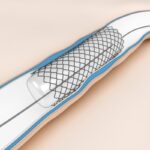Original title: Outcome impact of coronary revascularization strategy reclassification with fractional flow reserve at time of diagnostic angiography. Reference: Van Belle E et al. Circulation. 2014 Jan 14;129(2):173-85. Any comprehensive registry has not been yet published that evaluates the impact of fractional coronary flow reserve (FFR) to change the strategy of revascularization on individual patients referred for diagnostic…
Malapposition in drug-eluting stents. Much more common and much less serious than we thought
Original title: Incidences, Predictors, and Clinical Outcomes of Acute and Late Stent Malapposition Detected by Optical Coherence Tomography After Drug-Eluting Stent Implantation Reference: Im E. et al. CircCardiovascInterv. 2014 Jan 14. [Epubahead of print] This paper analyzed the imaging of 351 patients by optical coherence tomography (OCT) who received drug-eluting stents over 356 lesions between 2009 and…
Ischemic versus anatomical risk. Is anyone better to help us decide therapeutically?
Original title: Predicting Outcome in the COURAGE Trial. Coronary Anatomy Versus Ischemia. Reference: G. B. John Mancini et al. J Am Coll Cardiol Intv 2013, Article in press. Anatomical risk, ischemic amount or a combination of both, are often factors taken into account for estimating the prognosis or choose a treatment strategy. The COURAGE study (Clinical Outcomes Utilizing…
Everolimus-eluting stent and DEB in restenosis for BMS. Good results of both with some expected differences.
Original title: A Randomized Comparison of Drug-Eluting Balloon Versus Everolimus-Eluting Stent in Patients With Bare-Metal Stent In-Stent Restenosis: The RIBS V Clinical Trial. Reference: Fernando Alfonso et al. J Am Coll Cardiol. 2014; Epub ahead of print. Drug-eluting stents (DES) have proven to be superior in terms of restenosis than bare metal stents (BMS). BMS, however due…
Longer follow-up registry of angioplasty in left main coronary artery. Significant differences according to the diseased segment.
Original title: The DELTA Registry (Drug-Eluting Stent for Left Main Coronary Artery Disease): A Multicenter registry Evaluating Percutaneous Coronary Intervention Versus Coronary Artery Bypass Grafting for left Main Treatment Reference: Naganuma T, et al. J Am Coll Cardiol Intv 2013;6:1242–9 Angioplasty of the unprotected left coronary trunk has increased significantly in recent years showing good results. Currently the…
Stent reestenosis, the only subgroup that benefits from longer double antiaggregation
Original title: Short vs. Long Term Duration of Dual Antiplatelet Therapy in Patients treated for InstentRestenosis. A PRODIGY Trial substudy. Reference: Gianluca Campo el al. J Am CollCardiol, article in press. In the study PRODIGY (Prolonging Dual Antiplatelet Treatment After Grading Stent- Induced Intimal Hyperplasia) we found that the 24 months ratio of dual antiaggregation was not…
Unprotected trunk in diabetics: angioplasty with good long-term results but more revascularization
Original title: Coronary artery bypass graft versus percutaneous coronary intervention with drug-eluting stent implantation for diabetic patients with unprotected left main coronary artery disease: D-DELTA registry. Reference: Meliga Emanuele, et al. EuroIntervention 2013; 9:803-808 Diabetes increases cardiovascular risk events because of their involvement in diffuse form of the vessels, thereby generating more events and changes in revascularization strategy…
Everolimus -eluting stent to 3 years, most security was the key difference.
Original title: Everolimus-eluting stents in patients undergoing percutaneous coronary Intervention: Final 3-year results of the Clinical Evaluation of the XIENCE V Everolimus Eluting Coronary Stent System in the Treatment of Subjects With de Novo Native Coronary Artery Lesions trial. Reference: Sorin J. Brener et al. Am Heart J 2013;0:1-8. The XIENCE stent (Abbott Vascular, Santa Clara, CA) is…
Primary angioplasty with 2nd generation drug-eluting stents
Original title: Stent thrombosis with second-generation drug-eluting stents compared with bare-metal stents: Network meta-analysis of primary percutaneous coronary intervention trials in ST-segment–elevation myocardial infarction. Reference: Circ Cardiovasc Interv. 2013; Epub ahead of print. To compare the safety and efficacy of 2nd generation drug-eluting stents (DES) versus bare metal stents (BMS) in the context of primary angioplasty was conducted…
Angioplasty or medical therapy in patients with documented ischemia
Original title: Percutaneous coronary intervention outcomes in patients with stable obstructive coronary artery disease and myocardial ischemia: A collaborative meta-analysis of contemporary randomized clinical trials. Reference: Stergiopoulos K el al. JAMA Intern Med 2013; DOI:10.1001/jamainternmed.2013 The amount in ischemic patients with stable coronary heart disease is associated with poor prognosis. However, it is unclear whether revascularization to reduce…









